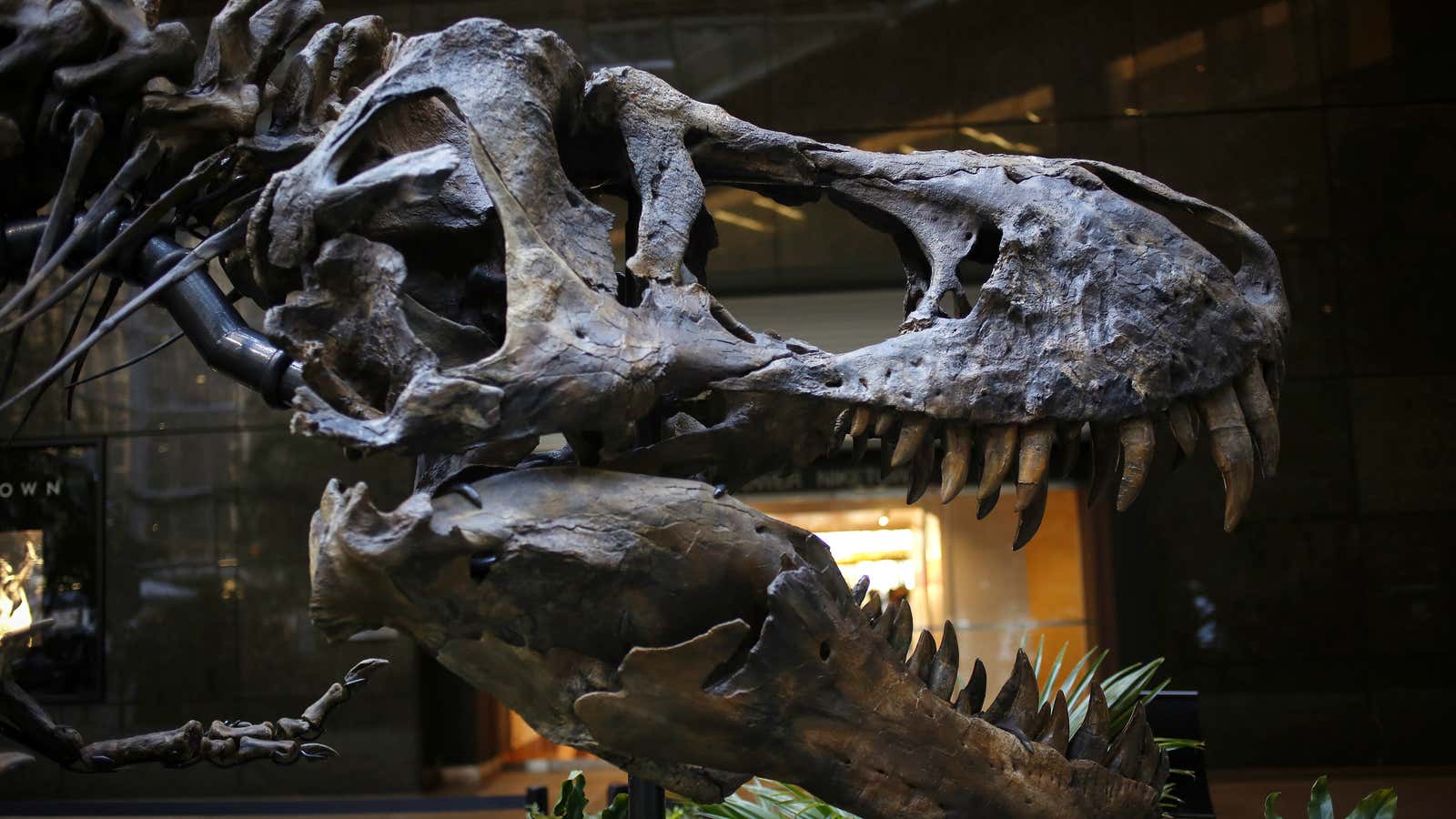The human urge to recreate the world of dinosaurs never really gets old—Jurassic World‘s blockbusting is but the latest proof. Though the movie takes some liberties in imagining its dinosaurs, nature is hardly less creative. Recent discoveries include a long-nosed Tyrannosaur, a cat-sized microraptor, a four-winged flying dinosaur, the “chicken from hell,” and, as one scientist put it, a “colossal, slow-moving, horse-headed, hump-backed dinosaur that looks like something out of a bad sci-fi movie.”
And scientists think there are many more entirely new types of dinosaurs we have yet to discover. How many more exactly, though?
In 2006, a pair of scientists took a stab at this question. According to their model, Steve Wang of Swarthmore College and the University of Pennsylvania’s Peter Dodson estimated that 1,844 discoverable dinosaur genera—the taxonomic level one step up from species—existed during the Mesozoic Era (252 million to 66 million years ago).
If we keep discovering new dinosaurs at a pace of 15 or so a year, we will have found half of the discoverable dinosaur types in 2037, according to their calculations.

But wait. That calculation was from 2006, when 527 genera had been identified. Since then, the surge in discoveries in the world’s hitherto little explored corners—in particular, Asia, Latin America and, increasingly, Africa—means we’re finding new genera at an even faster rate. Scientists have now named around 800 dinosaur genera—about 43% of the total estimated by Wang and Dodson.
In other words, we’re already nearly halfway to finding all the dinosaur types that mankind will ever dig up—which means we’re fast approaching “peak dinosaur,” the point at which we’ll never find more dinosaur types than we’ve already discovered. On top of that, we’ve found many more species than we’ve yet had a chance to classify, says Matthew Carrano, a paleontologist at the Smithsonian’s National Museum of Natural History
If that leaves you nostalgic for a bygone time of seemingly endless paleontological possibility, take heart. The (likely) higher volume of new discoveries, says Carrano, implies the number of undiscovered genera could also be much bigger.
But why would that backlog influence our guess of how many yet-unknown dinosaur types remain at large?
A faster pace of discoveries suggests more richness of the overall dinosaur biodiversity. This is why the annual rate of discovery is a crucial factor in reckoning what other types, and how many, might still be out there. For instance, in 1990, when we were discovering new dinosaur types at a rate of about six per year, Dodson estimated the existence of 900-1,200 genera (pdf). By the time he and Wang made their 2006 calcuation, the annual average neared 15.
Now it’s probably closer to 20. Is that enough to affect Dodson and Wang’s 2006 calculation? We asked Wang about that. Though he hadn’t updated the 2006 projections, he did indeed suspect that the denominator—i.e. the predicted number of discoverable genera—would likely increase.
“This is just a guess, based on the continued high rate of discovery of new genera in the last few years,” Wang says. “I would not be surprised if the best estimate now would be well over 2,000 genera.”
There’s something else here to consider, though. Wang and Dodson’s model only calculated the number of genera that humans could possibly discover. But some dinosaur species might have lived on terrain that was hard to imprint. Geological forces likely destroyed rocks marked by bodies of others. This means a good many fossils are simply impossible to find—lost, quite literally, in the sands of time.
While we’ll therefore never know for sure how many dino types truly existed, Dale Russell, emeritus professor at the North Carolina Museum of Natural Sciences, put the total number—of discoverable and undiscoverable types—at 3,400.
In other words, despite our furious pace of discovery, 76% of all the non-bird dinosaur types that ever existed are still a complete mystery.
Here’s another pretty important factor to consider, though: That “non-bird” qualifier is not trivial. Wang, Dodson, and Russell only tallied flightless dinosaurs, leaving out legions of their winged cousins. The fact that birds—their descendants—are the most diverse group of vertebrates today suggests a rich biodiversity of their prehistoric forbears, say both Wang and Carrano.
Finally, there’s the problem piqued by some of Jurassic World‘s hottest stars: pteranodons and mosasaurs. Though they might be among the Mesozoic’s most charismatic megafauna, they are not, technically, dinosaurs. And since they and their cousins fall in the ancient reptile category, they don’t figure into these estimates either. That makes it even trickier to guess how many bony surprises remain lodged in the rocks. But it also hints that thousands more wonders yet await us.
